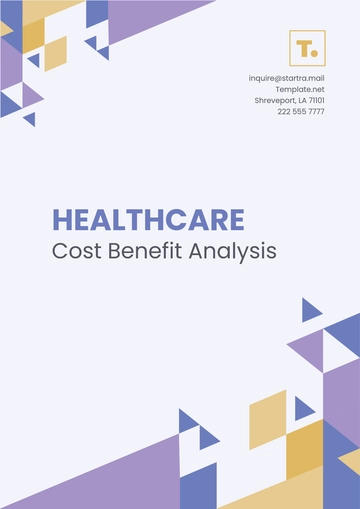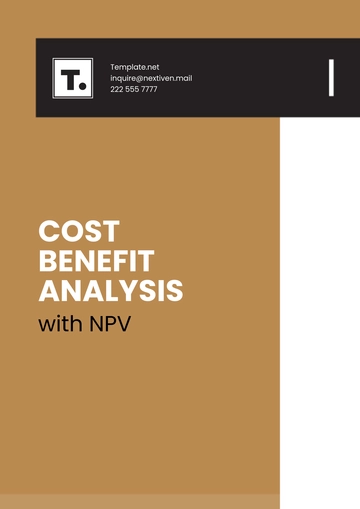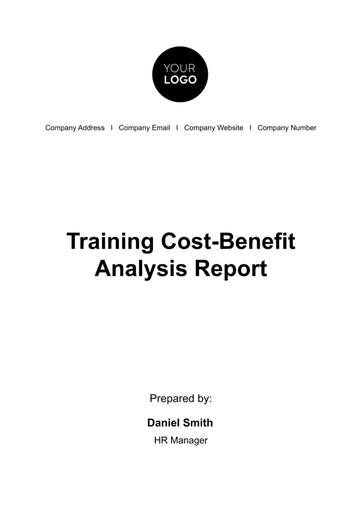Free Agriculture Compliance Financial Analysis

I. Introduction
The Agriculture Compliance Financial Analysis document provides an extensive examination of financial aspects within [Your Company Name]'s agricultural operations. This analysis is pivotal for understanding the intersection of financial performance and regulatory compliance, essential in navigating the complexities of the agricultural sector.
II. Financial Performance Analysis
A. Revenue Analysis
Revenue analysis in agriculture involves a meticulous breakdown of income sources. For [Your Company Name], revenue primarily derives from crop sales, livestock production, and government subsidies or grants. Over the past five fiscal years, [Your Company Name] has experienced a steady growth trajectory in crop sales, averaging approximately $5 million annually. Factors contributing to this growth include strategic crop rotation practices and favorable market conditions during key harvesting periods.
Livestock production also plays a significant role in revenue generation, contributing an average of $5 million annually. However, revenue from this segment exhibits variability due to market demand fluctuations and seasonal factors influencing breeding cycles and pricing dynamics.
B. Cost Analysis
Analyzing operational costs is critical for assessing overall profitability and efficiency within [Your Company Name]'s agricultural operations. Major cost components include labor expenses, equipment maintenance, seed and fertilizer expenditures, as well as overhead costs encompassing utilities and administrative expenses.
Labor costs represent the largest share of operational expenses, accounting for approximately 30% of total costs. [Your Company Name] employs a skilled workforce to manage planting, harvesting, and livestock care operations, ensuring operational continuity and quality output. However, seasonal labor demands and wage fluctuations during peak seasons impact cost predictability and overall financial planning.
Equipment maintenance constitutes another significant cost factor, comprising 20% of total expenses. [Your Company Name] maintains a robust fleet of agricultural machinery and implements proactive maintenance schedules to optimize operational uptime and mitigate unforeseen repair costs.
Seed and fertilizer expenses, totaling 25% of operational costs, are essential for maximizing crop yields and ensuring soil fertility. [Your Company Name] integrates sustainable farming practices and precision agriculture techniques to minimize input wastage and optimize resource allocation.
C. Profitability Metrics
Assessing profitability metrics provides valuable insights into [Your Company Name]'s financial health and operational efficiency. Gross profit margin, a key indicator of profitability, averages around 40% annually. This metric reflects [Your Company Name]'s effective cost management strategies and operational efficiencies across crop and livestock production segments.
Net profit margin, after accounting for all operating expenses and tax liabilities, stands at approximately 15%. This metric underscores [Your Company Name]'s ability to sustain profitability amidst market volatility and regulatory compliance challenges. Maintaining a healthy profit margin is imperative for reinvesting in infrastructure upgrades, technology enhancements, and employee training initiatives essential for long-term sustainability and growth.
III. Compliance Costs Evaluation
A. Regulatory Compliance Costs
Compliance with regulatory standards is a cornerstone of [Your Company Name]'s operational framework, necessitating significant financial resources and strategic planning. Regulatory requirements span environmental stewardship, labor practices, food safety standards, and animal welfare protocols, each imposing unique compliance obligations and cost implications.
Annual compliance costs for [Your Company Name] amount to approximately $10 million, encompassing investments in sustainable farming practices, regulatory reporting, and workforce training initiatives. Environmental compliance initiatives, such as soil conservation measures and water management strategies, require ongoing capital investments to mitigate environmental impact and ensure long-term sustainability.
Labor compliance costs reflect [Your Company Name]'s commitment to fair labor practices and employee welfare, encompassing wage and hour regulations, workplace safety standards, and employee benefit programs. [Your Company Name] allocates resources towards training programs and occupational health initiatives to uphold workforce productivity and regulatory compliance standards.
Food safety and animal welfare compliance obligations entail rigorous inspection regimes and certification requirements to safeguard product quality and consumer confidence. [Your Company Name] implements stringent hygiene protocols and traceability systems across its supply chain to ensure adherence to food safety regulations and uphold industry-leading standards.
B. Compliance Investment Analysis
Strategic investments in compliance technologies and sustainable agricultural practices are instrumental in enhancing [Your Company Name]'s operational efficiency and regulatory compliance posture. [Your Company Name] has proactively invested in advanced irrigation systems to optimize water usage and align with local water conservation mandates. These investments not only reduce operational costs but also mitigate environmental impact, reinforcing [Your Company Name]'s commitment to sustainable resource management.
Moreover, [Your Company Name] has adopted precision agriculture technologies, including GPS-guided machinery and remote sensing technologies, to enhance crop yield forecasting and optimize input application rates. These innovations improve farm productivity while minimizing environmental footprint, positioning [Your Company Name] as a leader in agricultural innovation and sustainable farming practices.
IV. Risk Management
A. Risk Assessment
Effective risk management is essential for [Your Company Name] to mitigate potential threats to financial performance and operational continuity. Market risks, such as fluctuating commodity prices and global trade uncertainties, pose significant challenges to [Your Company Name]'s revenue streams and profitability margins. [Your Company Name] conducts regular market analyses and engages in hedging strategies to minimize exposure to price volatility and stabilize revenue projections.
Regulatory risks encompass changes in agricultural policies, trade tariffs, and environmental regulations that impact [Your Company Name]'s operational framework and compliance obligations. [Your Company Name] maintains proactive engagement with regulatory authorities and industry stakeholders to stay abreast of legislative developments and anticipate regulatory shifts affecting agricultural operations.
B. Mitigation Strategies
Mitigating financial risks requires [Your Company Name] to implement robust strategies that enhance resilience and safeguard against potential disruptions. Diversification of crop portfolios and strategic partnerships with market intermediaries enable [Your Company Name] to navigate market volatility and capitalize on emerging opportunities. Forward contracts with buyers and suppliers provide price stability and ensure consistent revenue streams, mitigating risks associated with seasonal market fluctuations.
Furthermore, [Your Company Name] prioritizes investments in infrastructure resilience and contingency planning to mitigate operational risks stemming from natural disasters, disease outbreaks, or supply chain disruptions. These proactive measures bolster [Your Company Name]'s adaptive capacity and operational agility, reinforcing its market leadership and long-term sustainability in the agricultural sector.
V. Financial Forecasting
A. Budgeting
Robust budgeting practices are integral to [Your Company Name]'s financial planning and resource allocation strategies. Annual operating budgets are meticulously prepared based on historical performance data, anticipated revenue streams, and projected cost structures across crop and livestock production segments. Budgetary allocations prioritize investments in technology upgrades, equipment maintenance, and workforce development initiatives essential for enhancing operational efficiency and maintaining compliance with regulatory standards.
Operating Budget
The operating budget outlines the expected revenue and expenses for the upcoming fiscal year. It is crucial to ensure that the financial resources are allocated efficiently to sustain and grow the agricultural operations. Below is an operating budget for [Your Company Name]:
Category | Amount ($) | Percentage of Total Budget (%) |
|---|---|---|
Crop Production | 1,200,000 | 30% |
Livestock Production | 800,000 | 20% |
Equipment Maintenance | 600,000 | 15% |
Labor Costs | 700,000 | 17.5% |
Seed and Fertilizer | 500,000 | 12.5% |
Utilities and Overhead | 200,000 | 5% |
Crop production and livestock production account for the largest portions of the budget, reflecting their significance in generating revenue. Equipment maintenance and labor costs are also substantial, underscoring the importance of keeping machinery in optimal condition and maintaining a skilled workforce.
Capital Budget
Capital budgets outline strategic investments in infrastructure expansion, facility upgrades, and technological innovations aimed at optimizing production capacities and improving supply chain resilience. [Your Company Name] adopts a phased approach to budget execution, ensuring alignment with organizational objectives and regulatory compliance obligations.
Investment Category | Amount ($) | Timeframe |
|---|---|---|
Irrigation System Upgrade | 300,000 | Year 1 |
Precision Agriculture Tools | 400,000 | Year 2 |
Greenhouse Construction | 500,000 | Year 3 |
Renewable Energy Installations | 200,000 | Year 4 |
IT Infrastructure Upgrade | 100,000 | Year 5 |
Investments in precision agriculture tools and irrigation system upgrades are scheduled for the first two years, aimed at enhancing productivity and water efficiency. The construction of greenhouses in Year 3 is a strategic move to extend the growing season and diversify crop production. Renewable energy installations in Year 4 are part of sustainability initiatives to reduce operational costs and environmental impact. Upgrading IT infrastructure in Year 5 will improve data management and operational efficiency.
B. Financial Projections
Forecasting future financial performance requires [Your Company Name] to integrate market trends, regulatory changes, and operational efficiencies into comprehensive financial projections. Revenue growth projections of 5% annually reflect [Your Company Name]'s expansion into new markets and adoption of sustainable farming practices designed to enhance crop yields and mitigate environmental impact.
Revenue Projections
Below are the projected revenues for the next five years:
Year | Crop Production ($) | Livestock Production ($) | Total Revenue ($) |
|---|---|---|---|
Year 1 | 1,500,000 | 900,000 | 2,400,000 |
Year 2 | 1,575,000 | 945,000 | 2,520,000 |
Year 3 | 1,653,750 | 992,250 | 2,646,000 |
Year 4 | 1,736,438 | 1,041,863 | 2,778,300 |
Year 5 | 1,823,260 | 1,093,956 | 2,917,216 |
Revenue projections indicate steady growth in both crop and livestock production. The implementation of precision agriculture tools and advanced irrigation systems is expected to boost crop yields and enhance overall productivity. Strategic partnerships and market expansion initiatives contribute to increased livestock production revenue.
Expense Projections
Below are the projected expenses for the next five years:
Year | Labor Costs ($) | Equipment Maintenance ($) | Seed and Fertilizer ($) | Utilities and Overhead ($) | Total Expenses ($) |
|---|---|---|---|---|---|
Year 1 | 735,000 | 630,000 | 525,000 | 210,000 | 2,100,000 |
Year 2 | 771,750 | 661,500 | 551,250 | 220,500 | 2,205,000 |
Year 3 | 810,338 | 694,575 | 578,813 | 231,525 | 2,315,250 |
Year 4 | 850,854 | 729,304 | 607,754 | 243,101 | 2,430,412 |
Year 5 | 893,397 | 765,769 | 638,142 | 255,256 | 2,552,564 |
Expense projections also show a gradual increase, reflecting the rising costs associated with labor, equipment maintenance, and agricultural inputs. Utilities and overhead costs are expected to increase moderately, aligning with overall operational growth. Effective cost management strategies are essential to ensure that expenses do not outpace revenue growth, maintaining profitability.
Profitability Projections
Below are the projected profitability metrics for the next five years:
Year | Gross Profit ($) | Gross Profit Margin (%) | Net Profit ($) | Net Profit Margin (%) |
|---|---|---|---|---|
Year 1 | 1,200,000 | 50% | 300,000 | 12.5% |
Year 2 | 1,260,000 | 50% | 315,000 | 12.5% |
Year 3 | 1,323,000 | 50% | 330,750 | 12.5% |
Year 4 | 1,389,150 | 50% | 346,538 | 12.5% |
Year 5 | 1,458,608 | 50% | 363,304 | 12.5% |
Profitability projections indicate a stable gross profit margin of 50%, reflecting [Your Company Name]'s effective cost management and revenue optimization strategies. The net profit margin remains at 12.5%, ensuring sufficient profitability to reinvest in strategic initiatives and sustain operational growth.
Sensitivity Analysis
Sensitivity analysis evaluates how changes in key variables, such as market prices, input costs, and regulatory changes, impact financial projections. This analysis helps [Your Company Name] anticipate potential risks and develop contingency plans.
Variable | Scenario 1: Price Decrease (10%) | Scenario 2: Cost Increase (10%) | Scenario 3: Regulatory Changes |
|---|---|---|---|
Crop Production | 1,350,000 | 1,500,000 | 1,450,000 |
Livestock Production | 810,000 | 900,000 | 850,000 |
Total Revenue | 2,160,000 | 2,400,000 | 2,300,000 |
Total Expenses | 2,100,000 | 2,310,000 | 2,250,000 |
Net Profit | 60,000 | 90,000 | 50,000 |
The sensitivity analysis illustrates how a 10% decrease in crop and livestock prices would significantly reduce net profit to $60,000. Similarly, a 10% increase in operational costs would decrease net profit to $90,000. Regulatory changes could also impact profitability, necessitating proactive risk management strategies to mitigate potential financial impacts.
C. Investment and Growth Strategies
Investment and growth strategies are essential for sustaining long-term financial health and competitive advantage. [Your Company Name] focuses on strategic investments in technology, infrastructure, and market expansion to drive growth and improve financial performance.
Technology Investments
Investing in advanced technologies, such as precision agriculture tools, automated machinery, and data analytics platforms, enhances operational efficiency and productivity. These investments reduce input wastage, optimize resource allocation, and improve crop yields, contributing to revenue growth.
Infrastructure Upgrades
Upgrading infrastructure, including irrigation systems, storage facilities, and transportation networks, is critical for maintaining operational efficiency and minimizing post-harvest losses. Infrastructure investments enhance supply chain resilience and ensure timely delivery of agricultural products to market.
Market Expansion
Expanding into new markets and diversifying product portfolios are strategic initiatives to increase revenue streams and mitigate market risks. [Your Company Name] explores opportunities in emerging markets, develops value-added products, and establishes strategic partnerships with distributors and retailers.
Sustainability Initiatives
Implementing sustainability initiatives, such as renewable energy installations, water conservation practices, and organic farming techniques, aligns with regulatory compliance and enhances [Your Company Name]'s reputation as a responsible and eco-friendly agricultural enterprise. These initiatives also reduce operational costs and improve long-term profitability.
Workforce Development
Investing in workforce development through training programs, skill enhancement workshops, and career advancement opportunities ensures a skilled and motivated workforce. A competent workforce drives operational excellence, innovation, and adherence to compliance standards, contributing to overall financial performance.
VI. Conclusion
The Agriculture Compliance Financial Analysis underscores [Your Company Name]'s commitment to financial transparency, regulatory compliance, and sustainable agricultural practices. By conducting a comprehensive analysis of revenue sources, cost structures, compliance costs, risk management strategies, and financial forecasts, [Your Company Name] aims to optimize operational efficiency, mitigate financial risks, and capitalize on growth opportunities in the dynamic agricultural sector.
- 100% Customizable, free editor
- Access 1 Million+ Templates, photo’s & graphics
- Download or share as a template
- Click and replace photos, graphics, text, backgrounds
- Resize, crop, AI write & more
- Access advanced editor
Analyze compliance costs with Template.net's customizable and editable Agriculture Compliance Financial Analysis Template. Utilize the AI Editor Tool for detailed financial assessments. This user-friendly template ensures accurate analysis, enhancing financial planning and regulatory adherence in your agricultural operations.





























